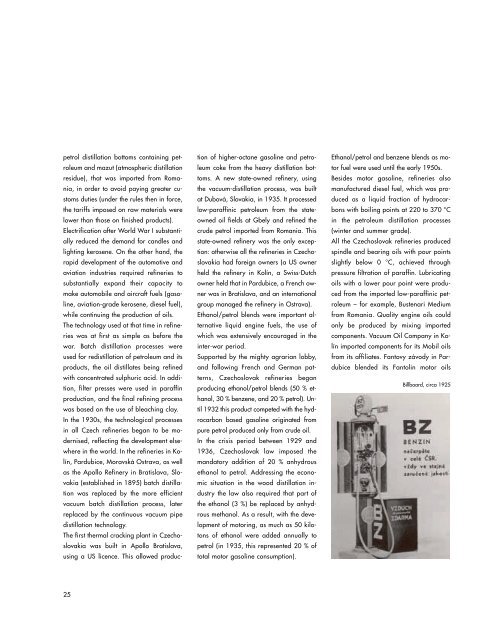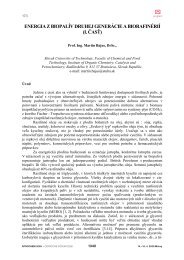THE CENTURY OF PETROL - Petroleum.cz
THE CENTURY OF PETROL - Petroleum.cz
THE CENTURY OF PETROL - Petroleum.cz
Create successful ePaper yourself
Turn your PDF publications into a flip-book with our unique Google optimized e-Paper software.
petrol distillation bottoms containing petroleum<br />
and mazut (atmospheric distillation<br />
residue), that was imported from Romania,<br />
in order to avoid paying greater customs<br />
duties (under the rules then in force,<br />
the tariffs imposed on raw materials were<br />
lower than those on finished products).<br />
Electrification after World War I substantially<br />
reduced the demand for candles and<br />
lighting kerosene. On the other hand, the<br />
rapid development of the automotive and<br />
aviation industries required refineries to<br />
substantially expand their capacity to<br />
make automobile and aircraft fuels (gasoline,<br />
aviation-grade kerosene, diesel fuel),<br />
while continuing the production of oils.<br />
The technology used at that time in refineries<br />
was at first as simple as before the<br />
war. Batch distillation processes were<br />
used for redistillation of petroleum and its<br />
products, the oil distillates being refined<br />
with concentrated sulphuric acid. In addition,<br />
filter presses were used in paraffin<br />
production, and the final refining process<br />
was based on the use of bleaching clay.<br />
In the 1930s, the technological processes<br />
in all Czech refineries began to be modernised,<br />
reflecting the development elsewhere<br />
in the world. In the refineries in Kolín,<br />
Pardubice, Moravská Ostrava, as well<br />
as the Apollo Refinery in Bratislava, Slovakia<br />
(established in 1895) batch distillation<br />
was replaced by the more efficient<br />
vacuum batch distillation process, later<br />
replaced by the continuous vacuum pipe<br />
distillation technology.<br />
The first thermal cracking plant in Czechoslovakia<br />
was built in Apollo Bratislava,<br />
using a US licence. This allowed produc-<br />
25<br />
tion of higher-octane gasoline and petroleum<br />
coke from the heavy distillation bottoms.<br />
A new state-owned refinery, using<br />
the vacuum-distillation process, was built<br />
at Dubová, Slovakia, in 1935. It processed<br />
low-paraffinic petroleum from the stateowned<br />
oil fields at Gbely and refined the<br />
crude petrol imported from Romania. This<br />
state-owned refinery was the only exception:<br />
otherwise all the refineries in Czechoslovakia<br />
had foreign owners (a US owner<br />
held the refinery in Kolín, a Swiss-Dutch<br />
owner held that in Pardubice, a French owner<br />
was in Bratislava, and an international<br />
group managed the refinery in Ostrava).<br />
Ethanol/petrol blends were important alternative<br />
liquid engine fuels, the use of<br />
which was extensively encouraged in the<br />
inter-war period.<br />
Supported by the mighty agrarian lobby,<br />
and following French and German patterns,<br />
Czechoslovak refineries began<br />
producing ethanol/petrol blends (50 % ethanol,<br />
30 % benzene, and 20 % petrol). Until<br />
1932 this product competed with the hydrocarbon<br />
based gasoline originated from<br />
pure petrol produced only from crude oil.<br />
In the crisis period between 1929 and<br />
1936, Czechoslovak law imposed the<br />
mandatory addition of 20 % anhydrous<br />
ethanol to petrol. Addressing the economic<br />
situation in the wood distillation industry<br />
the law also required that part of<br />
the ethanol (3 %) be replaced by anhydrous<br />
methanol. As a result, with the development<br />
of motoring, as much as 50 kilotons<br />
of ethanol were added annually to<br />
petrol (in 1935, this represented 20 % of<br />
total motor gasoline consumption).<br />
Ethanol/petrol and benzene blends as motor<br />
fuel were used until the early 1950s.<br />
Besides motor gasoline, refineries also<br />
manufactured diesel fuel, which was produced<br />
as a liquid fraction of hydrocarbons<br />
with boiling points at 220 to 370 °C<br />
in the petroleum distillation processes<br />
(winter and summer grade).<br />
All the Czechoslovak refineries produced<br />
spindle and bearing oils with pour points<br />
slightly below 0 °C, achieved through<br />
pressure filtration of paraffin. Lubricating<br />
oils with a lower pour point were produced<br />
from the imported low-paraffinic petroleum<br />
– for example, Bustenari Medium<br />
from Romania. Quality engine oils could<br />
only be produced by mixing imported<br />
components. Vacuum Oil Company in Kolín<br />
imported components for its Mobil oils<br />
from its affiliates. Fantovy závody in Pardubice<br />
blended its Fantolin motor oils<br />
Billboard, circa 1925



